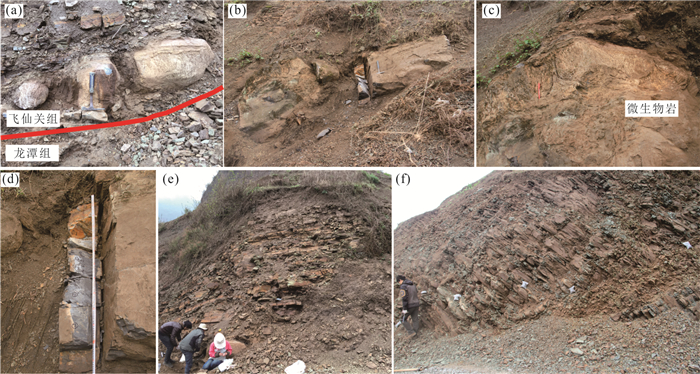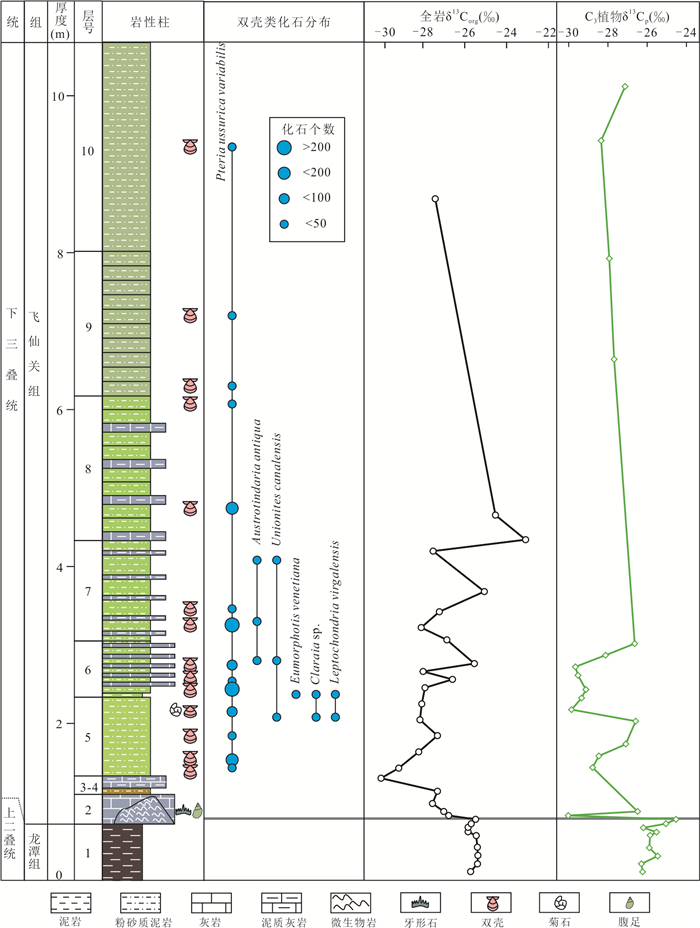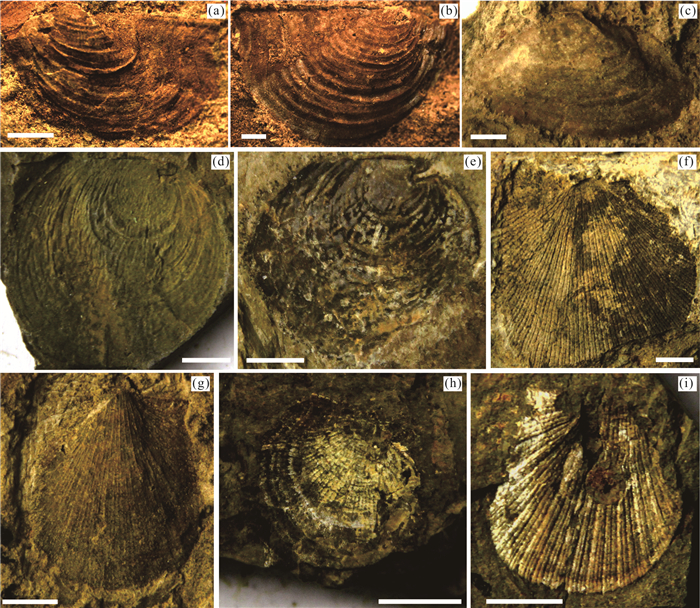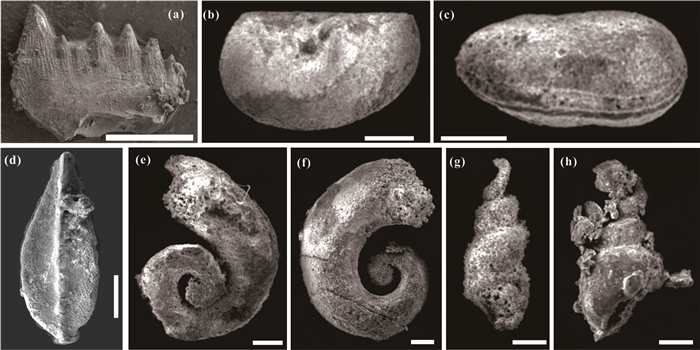Organic Carbon Isotopes and Biostratigraphic Corelation during Permian-Triassic Transition in Western Guizhou and Eastern Yunnan
-
摘要: 二叠纪-三叠纪之交海、陆相地层对比研究对陆相二叠系-三叠系界线的定义以及全面认识该全球性重大生物与环境突变事件具有重要意义,是当前国际古生物学与地层学研究的重点和难点.选择贵州六盘水仲河二叠系-三叠系界线剖面为研究对象,系统研究了该剖面的化石面貌和有机碳同位素演变特征.结合黔西滇东地区二叠纪-三叠纪之交良好的陆相、海陆过渡相和浅海碎屑岩相地层记录,初步搭建了海、陆相生物地层与有机碳同位素地层对比框架.值得关注的是,综合已有研究的陆相和海陆过渡相剖面植物有机碳同位素和海相剖面无机碳同位素数据,发现均存在相同的碳同位素演变特征,且与生物地层对比方案一致.据此,认为高分辨率的有机碳同位素化学地层是实现海-陆相地层对比的有效手段之一.Abstract: The correlation between the marine and terrestrial Permian-Triassic (P-Tr) strata has a great significance for the definition of the terrestrial P-Tr boundary and the comprehensive understanding for the nature of this global biotic and environmental event. In the present study, it investigated the fossils and organic carbon isotopes of the P-Tr boundary section of Zhonghe in Liupanshui City, Guizhou Province. A preliminary framework for the correlation of marine and terrestrial biostratigraphy and organic carbon isotope stratigraphy was established by combining the previous studies in this area. Moreover, the organic carbon isotopes of plants and marine inorganic carbon isotopes share the same trends, which are confirmed by the evidence of the biostratigraphic correlation framework. Accordingly, it concludes that high-resolution chemostratigraphy of organic carbon isotope is one of the effective proxies to achieve marine and terrestrial stratigraphic correlation.
-
图 1 研究剖面地理位置及古地理图
a.仲河剖面交通位置图;b.华南二叠纪-三叠纪之交古地理图(据Yin et al., 2014修改);图中红色五角星代表研究剖面位置
Fig. 1. The location of the Zhonghe Section and paleogeographic map of the study area
图 3 仲河剖面地层柱状图及化石分布与有机碳同位素曲线图
其中δ13Corg为全岩有机碳同位素,数据来源于Wignall et al.(2020).图中的灰色横线代表有机碳同位素开始负偏的位置
Fig. 3. Lithostratigraphy, fossil distribution and organic carbon isotopes of the Zhonghe Section
图 4 仲河剖面飞仙关组双壳化石
a,b. Pteria ussurica variabilis;a.左壳,产自仲河剖面飞仙关组下部,标本号ZH-6-342;b. 右壳,产自仲河剖面飞仙关组下部,标本号ZH-5-254;c. Unionites canalensis,左壳,产自仲河剖面飞仙关组下部,标本号ZH-8-284;d,e. Claraia wangi;d. 右壳,产自仲河剖面飞仙关组下部,标本号ZH-5-156;e. 右壳,产自仲河剖面飞仙关组下部,标本号ZH-4-555;f. Leptochondria virgalensis,右壳,产自仲河剖面飞仙关组下部,标本号ZH-5-178;g. Eumorphotis venetiana;g. 左壳,产自仲河剖面飞仙关组下部,标本号ZH-5-180;h,i. Eumorphotis multiformis;h.左壳,产自仲河剖面飞仙关组下部,标本号ZH-4-199;i. 左壳,产自仲河剖面飞仙关组下部,标本号ZH-5-173.其中,a~c中的比例尺为1 mm,d~i的比例尺为5 mm
Fig. 4. The bivalves from Feixianguan Formation of the Zhonghe Section
图 6 黔西滇东地区二叠纪-三叠纪之交不同相区有机碳同位素和海相煤山剖面碳酸盐岩碳同位素对比图
a.岔河剖面有机碳同位素趋势,其中数据来源于Shen et al.(2011),Wu et al.(2021);b.赤那河剖面有机碳同位素趋势,其中数据来源于Chu et al.(2020),Wu et al.(2021);c.仲河剖面有机碳同位素趋势,其中全岩有机碳同位素数据来源于Wignall et al.(2020);d.煤山剖面碳酸盐岩碳同位素趋势,数据来源于Xie et al.(2007);Shen et al.(2011);Burgess et al.(2014).灰色阴影代表有机碳同位素开始负偏
Fig. 6. The chemostratigraphic correlation between the organic carbon isotopes of western Guizhou and eastern Yunnan and the carbonate carbon isotopes of Meishan Section
-
Benton, M. J., 2015. When Life nearly Died: The Greatest Mass Extinction of all Time. Choice Reviews Online, 53(4): 53-1793. Burgess, S. D., Bowring, S., Shen, S. Z., 2014. High-Precision Timeline for Earth's most Severe Extinction. Proceedings of the National Academy of Sciences, 111(9): 3316-3321. https://doi.org/10.1073/pnas.1317692111 Chen, Y., Ye, Q., Jiang, H. S., et al., 2019. Conodonts and Carbon Isotopes during the Permian-Triassic Transition on the Napo Platform, South China. Journal of Earth Science, 30(2): 244-257. https://doi.org/10.1007/s12583-018-0884-3 Chen, Z. Q., Benton, M. J., 2012. The Timing and Pattern of Biotic Recovery Following the End-Permian Mass Extinction. Nature Geoscience, 5(6): 375-383. https://doi.org/10.1038/ngeo1475 Chu, D. L., Grasby, S. E., Song, H. J., et al., 2020. Ecological Disturbance in Tropical Peatlands Prior to Marine Permian-Triassic Mass Extinction. Geology, 48(3): 288-292. https://doi.org/10.1130/g46631.1 Chu, D. L., Yu, J. X., Tong, J. N., et al., 2016. Biostratigraphic Correlation and Mass Extinction during the Permian-Triassic Transition in Terrestrial-Marine Siliciclastic Settings of South China. Global and Planetary Change, 146: 67-88. https://doi.org/10.1016/j.gloplacha.2016.09.009 Cui, Y., Bercovici, A., Yu, J. X., et al., 2017. Carbon Cycle Perturbation Expressed in Terrestrial Permian-Triassic Boundary Sections in South China. Global and Planetary Change, 148: 272-285. doi: 10.1016/j.gloplacha.2015.10.018 Feng, Z., Wei, H. B., Guo, Y., et al., 2020. From Rainforest to Herbland: New Insights into Land Plant Responses to the End-Permian Mass Extinction. Earth-Science Reviews, 204: 103153. https://doi.org/10.1016/j.earscirev.2020.103153 Fielding, C. R., Frank, T. D., McLoughlin, S., et al., 2019. Age and Pattern of the Southern High-Latitude Continental End-Permian Extinction Constrained by Multiproxy Analysis. Nature Communications, 10(1): 1-12. https://doi.org/10.1038/s41467-018-07934-z Gastaldo, R. A., Kamo, S. L., Neveling, J., et al., 2020. The Base of the Lystrosaurus Assemblage Zone, Karoo Basin, Predates the End-Permian Marine Extinction. Nature Communications, 11(1): 1428. https://doi.org/10.1038/s41467-020-15243-7 He, W. H., Shi, G. R., Yang, T. L., et al., 2016. Patterns of Brachiopod Faunal and Body-Size Changes across the Permian-Triassic Boundary: Evidence from the Daoduishan Section in Meishan Area, South China. Palaeogeography, Palaeoclimatology, Palaeoecology, 448: 72-84. https://doi.org/10.1016/j.palaeo.2015.11.023 Huang, Y. F., 2014. Extinction and Recovery of Bivalves during the Permian-Triassic Transition (Dissertation). China University of Geosciencies, Wuhan(in Chinese with English abstract). Huang, Y. F., Tong, J. N., 2014. Advance in the Study of the Permian-Triassic Bivalves. Advances in Earth Science, 29(8): 922-933(in Chinese with English abstract). Jiang, H. S., Lai, X. L., Sun, Y. D., et al., 2014. Permian-Triassic Conodonts from Dajiang (Guizhou, South China) and Their Implication for the Age of Microbialite Deposition in the Aftermath of the End-Permian Mass Extinction. Journal of Earth Science, 25(3): 413-430. https://doi.org/10.1007/s12583-014-0444-4 Jin, Y. G., Wang, Y., Wang, W., et al., 2000. Pattern of Marine Mass Extinction near the Permian-Triassic Boundary in South China. Science, 289(5478): 432-436. https://doi.org/10.1126/science.289.5478.432 Joachimski, M. M., Lai, X. L., Shen, S. Z., et al., 2012. Climate Warming in the Latest Permian and the Permian-Triassic Mass Extinction. Geology, 40(3): 195-198. https://doi.org/10.1130/g32707.1 Kozur, H. W., Weems, R. E., 2010. The Biostratigraphic Importance of Conchostracans in the Continental Triassic of the Northern Hemisphere. Geological Society, London, Special Publications, 334(1): 315-417. https://doi.org/10.1144/sp334.13 Miao, X., Chu, D. L., Tong, J. N., et al., 2021. Biostratigraphic Significance and Geometric Morphometrics of Euestheria Gutta (Crustacea: Branchiopoda: Spinicaudata): An Index Fossil of Continental Permian-Triassic Transitional Beds. Geological Journal. https://doi.org/10.1002/gj.4096 Nowak, H., Schneebeli-Hermann, E., Kustatscher, E., 2019. No Mass Extinction for Land Plants at the Permian-Triassic Transition. Nature Communications, 10(1): 1-8. https://doi.org/10.1038/s41467-018-07945-w Peng, Y. Q., Shi, G. R., 2009. Life Crises on Land across the Permian-Triassic Boundary in South China. Global and Planetary Change, 65(3-4): 155-165. https://doi.org/10.1016/j.gloplacha.2008.10.016 Scholze, F., Schneider, J. W., Werneburg, R., 2016. Conchostracans in Continental Deposits of the Zechstein-Buntsandstein Transition in Central Germany: Taxonomy and Biostratigraphic Implications for the Position of the Permian-Triassic Boundary within the Zechstein Group. Palaeogeography, Palaeoclimatology, Palaeoecology, 449: 174-193. https://doi.org/10.1016/j.palaeo.2016.02.021 Shen, S. Z., Crowley, J. L., Wang, Y., et al., 2011. Calibrating the End-Permian Mass Extinction. Science, 334(6061): 1367-1372. https://doi.org/10.1126/science.1213454 Shen, S. Z., Zhang, H., 2017. What Caused the Five Mass Extinctions? Chinese Science Bulletin, 62 (11): 1119-1135(in Chinese). doi: 10.1360/N972017-00013 Song, H. J., Kemp, D. B., Tian, L., et al., 2021. Thresholds of Temperature Change for Mass Extinctions. Nature Communications, 12(1): 1-8. https://doi.org/10.1038/s41467-021-25019-2 Song, H. J., Wignall, P. B., Tong, J. N., et al., 2013. Two Pulses of Extinction during the Permian-Triassic Crisis. Nature Geoscience, 6(1): 52-56. https://doi.org/10.1038/ngeo1649 Song, T., Tong, J. N., Tian, L., et al., 2019. Taxonomic and Ecological Variations of Permian-Triassic Transitional Bivalve Communities from the Littoral Clastic Facies in Southwestern China. Palaeogeography, Palaeoclimatology, Palaeoecology, 519: 108-123. https://doi.org/10.1016/j.palaeo.2018.02.027 Tong, J. N., Chu, D. L., Liang, L., et al., 2019. Triassic Integrative Stratigraphy and Timescale of China. Science China: Earth Sciences, 49(1): 194-226(in Chinese). Wang, S. Y., Yin, H. F., 2001. Study on the Terrestrial Premian-Triassic Boundary in Western Guizhou and Eastern Yunnan. China University of Geosciences Press, Wuhan (in Chinese). Ward, P. D., Montgomery, D. R., Smith, R., 2000. Altered River Morphology in South Africa Related to the Permian-Triassic Extinction. Science, 289(5485): 1740-1743. https://doi.org/10.1126/science.289.5485.1740 Wignall, P. B., Chu, D. L., Hilton, J. M., et al., 2020. Death in the Shallows: The Record of Permo-Triassic Mass Extinction in Paralic Settings, Southwest China. Global and Planetary Change, 189: 103176. https://doi.org/10.1016/j.gloplacha.2020.103176 Wu, Y. Y., Chu, D. L., Tong, J. N., et al., 2021. Six-Fold Increase of Atmospheric p$ {}_{\mathrm{C}{\mathrm{O}}_{2}} $ during the Permian-Triassic Mass Extinction. Nature Communications, 12(1): 1-8. https://doi.org/10.1038/s41467-021-22298-7 Xie, S. C., Pancost, R. D., Huang, J. H., et al., 2007. Changes in the Global Carbon Cycle Occurred as Two Episodes during the Permian-Triassic Crisis. Geology, 35(12): 1083-1086. doi: 10.1130/G24224A.1 Yin, H. F., 1983. Bivalves near the Permian-Triassic Boundary in South China. Geological Review, 29(4): 303-320(in Chinese with English abstract). Yin, H. F., Jiang, H. S., Xia, W. C., et al., 2014. The End-Permian Regression in South China and Its Implication on Mass Extinction. Earth-Science Reviews, 137: 19-33. https://doi.org/10.1016/j.earscirev.2013.06.003 Yin, H. F., Song, H. J., 2013. Mass Extinction and Pangea Integration during the Paleozoic-Mesozoic Transition. Science China: Earth Sciences, 56(11): 1791-1803(in Chinese). doi: 10.1007/s11430-013-4624-3 Yu, J. X., 2008. Floras and the Evolutionary Dynamics across the Permian-Triassic Boundary nearby the Border of Guizhou and Yunnan, South China (Dissertation). China University of Geosciences, Wuhan(in Chinese with English abstract). Yu, J. X., Broutin, J., Huang, Q. S., et al., 2010. Annalepis, a Pioneering Lycopsid Genus in the Recovery of the Triassic Land Flora in South China. Comptes Rendus Palevol, 9(8): 479-486. https://doi.org/10.1016/j.crpv.2010.09.004 Yu, J. X., Broutin, J., Chen, Z. Q., et al., 2015. Vegetation Changeover across the Permian-Triassic Boundary in Southwest China: Extinction, Survival, Recovery and Palaeoclimate: A Critical Review. Earth-Science Reviews, 149: 203-224. https://doi.org/10.1016/j.earscirev.2015.04.005. Zhang, H., Cao, C. Q., Liu, X. L., et al., 2016. The Terrestrial End-Permian Mass Extinction in South China. Palaeogeography, Palaeoclimatology, Palaeoecology, 448: 108-124. https://doi.org/10.1016/j.palaeo.2015.07.00 Zhang, H., Zhang, F. F., Chen, J. B., et al., 2021. Felsic Volcanism as a Factor Driving the End-Permian Mass Extinction. Science Advances, 7(47): eabh1390. https://doi.org/10.1126/sciadv.abh1390 黄云飞, 2014. 二叠纪-三叠纪之交双壳类的灭绝与复苏(博士学位论文). 武汉: 中国地质大学. 黄云飞, 童金南, 2014. 古-中生代之交双壳类演变研究进展. 地球科学进展, 29(8): 922-933. https://www.cnki.com.cn/Article/CJFDTOTAL-DXJZ201408008.htm 沈树忠, 张华, 2017. 什么引起五次生物大灭绝? 科学通报, 62(11): 1119-1135. https://www.cnki.com.cn/Article/CJFDTOTAL-KXTB201711007.htm 童金南, 楚道亮, 梁蕾, 等, 2019. 中国三叠纪综合地层和时间框架. 中国科学: 地球科学, 49(1): 194-226. https://www.cnki.com.cn/Article/CJFDTOTAL-JDXK201901010.htm 王尚彦, 殷鸿福, 2001. 滇东黔西陆相二叠纪-三叠纪界线地层研究. 武汉: 中国地质大学出版社. 殷鸿福, 1983. 古生代、中生代之交的华南双壳类: 分带、对比与危机. 地质论评, 29(4): 303-320. https://www.cnki.com.cn/Article/CJFDTOTAL-DZLP198304000.htm 殷鸿福, 宋海军, 2013. 古、中生代之交生物大灭绝与泛大陆聚合. 中国科学: 地球科学, 56(10): 1791-1803. https://www.cnki.com.cn/Article/CJFDTOTAL-JDXK201310002.htm 喻建新, 2008. 黔西滇东地区二叠系-三叠系之交古植物群及其演化动力(博士学位论文). 武汉: 中国地质大学. -










 下载:
下载:






